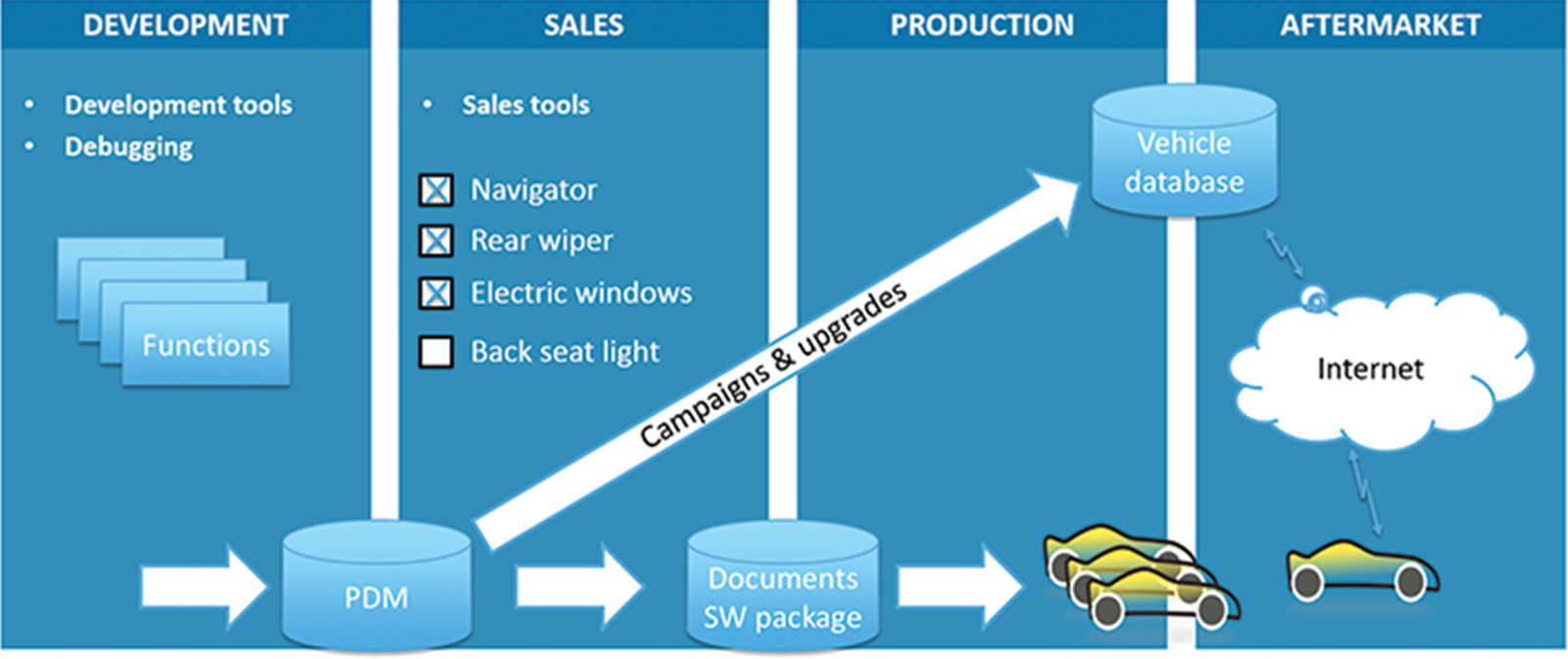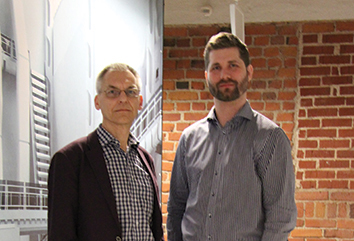
In the figure, the Lucid concept is illustrated schematically
Lucid concept is developped by Microteam Oy a member of Comatec Group. Lucid is, in short, a concept that can be used to implement the functions of machines, devices, and vehicles implemented cost-effectively, flexibly, and in a controlled way, throughout the life cycle.
“The Lucid concept allows software production to be automated. That was the idea when we began developing Lucid in the 1990s. As part of the Lucid concept we have also thought about what it requires from other stages. The number one demand for automation of software production is putting the other cornerstones into position,”says Microteam’s Chief Technology Officer Pertti Arjanne.
“One advantage is that the concept encompasses all stages of production, product development, sales, production, and secondary markets. The initial starting point was that there is no benefit in automating just one step. The task instead is to ensure that the automation is as comprehensive as possible. Not only effective from the operation point of view, but also to avoid business risks,” says Pertti.
“Traditionally, information travels through the design, production, and secondary market systems in ways that differ from each other, looking different in the different stages. With regard to the secondary markets, information is not always error-free. The fact that the vehicle can be modified during its lifetime, given new features, and updated with new software, cannot be done very reliably manually. The automated process of the Lucid process, on the other hand, is implemented reliably, and thus improves the quality of operations.”
The process discipline contained in Lucid is one of the cornerstones that the automation of software production has set for the Lucid concept.
“In the business world of production, software production process is more or less a separate part, and it is not organically integrated in production automation and production control as Lucid is,” Pertti explains.
“The Lucid concept includes processes and process discipline, which means that all the operating steps of the process are gone through, and they must follow certain principles.
“We strive to standardise everything possible that is part of the concept, whether it’s a new or an old part. This means that we specify the most accurate standards, and recommend deviations from them only rarely, in order that variants of physical devices, such as control units (ECU), should be kept to the minimum amount possible. This makes them more likely to be general-purpose,” says Pertti.
“As a process we have not really found anything negative that this concept would cause. On the contrary, we have been able to greatly cut out unnecessary things. The process discipline that is part of the Lucid concept could perhaps be imagined to raise costs, but compliance with the discipline actually saves costs rather than increasing them.
“The first time it’s used, compliance with the process discipline of the Lucid concept might seem laborious, but the second time round the benefits already become apparent,” Pertti says.
“The cornerstone here is the fact that you do it properly once, and after that you are able to re-use what you’ve previously done,” says Sales Manager Janne Virta.

From left: Microteam Oy’s Chief Technology Officer Pertti Arjanne, and Sales Manager Janne Virta.
“Microteam has implemented the Lucid concept in several projects, among them the design, manufacture, and maintenance of Volvo buses. The Lucid concept can of course work in other industries other than rolling stock, for which it was originally designed,” says Pertti.
“Lucid adapts to many kinds of settings, because its central principles are valid in almost every environment.
“Lucid is at its best in an environment in which a great variety of variants are created, and when they will not be made in awfully large runs.” Bus and coach production is a good example of the sort of environment in which Lucid is likely to give especially impressive added value.
“At its broadest, Lucid is very suitable for enterprise-type activities, such as at Volvo, where everything is integrated, from production control to secondary marketing.
Thanks to the Lucid concept, Volvo’s air conditioning system (HVAC) is clearly one of the most sophisticated in the field. This is an example of the added value that Lucid can bring. We are able to control the air conditioning system, and to continually and flexibly develop it, targeting it at different market areas, and with different features and functions,” Pertti says.
“At its simplest, we can offer to machine manufacturers, as a cloud service, the entire software infrastructure in such a way that the manufacturer needs nothing more than an internet connection. We can supply the ECUs of the control system, and we make everything ready so that they are free to produce the control functions,” Pertti says.
The automatic process of the Lucid concept enables dependable updates. Changes can be made to the vehicle, new features ca be added, and new software can be installed in it reliably, throughout its life cycle.
“The life cycle of buses, for instance, can be decades. Buses are likely to change hands several times during the life cycle. In such cases, the need usually arises for making a change to the intended use. A change in use often requires changes in function or physical components,” Pertti explains.
“Bus parts and components have their own life cycle in production. For example, in ECUs it’s from 5 to 10 years. During the lifetime of buses, the original ECUs are likely to be different than the new generation, and were implemented using different techniques.” The Lucid concept ensures that the old ECU can be directly replaced with a new one.
“The Lucid concept has focused very much on logical compatibility, thanks to which a change in the configuration of electronic parts and functions does not entail separate programming and testing. Testing is integrated into the system, and creation of the software is automated. The ready package is installed in the vehicle, for example when carrying out other maintenance on it.
“Behind everything, of course, is a complex system. However, when the Lucid concept has been properly implemented once, the first time round, all the changes that traditionally require manual programming can be done easily.”
“When Volvo manufactures buses, to take one example, the whole process involves many steps – product development and design, sales, production, and finally the finished vehicle is maintained throughout its life cycle.” Lucid is involved in every part of this entire chain.
“In the handling of buses, a bill of materials (BOM) is generated – this is a list of the part numbers, and contains absolutely everything that the bus will be made of.
“In addition to containing a colossal number of parts, each bus involves a massive amount of activities. The wipers must wipe, door mechanisms must open and close the doors, the air conditioning must operate correctly. All the functions must operate safely and according to local regulations, which are specific to each particular market.
“The wipers, door mechanisms, and air conditioning system are mechanical devices, and their operation is controlled by ECUs. The ECUs contain their own information. Every ECU is controlled through programming, and they cause mechanical devices to carry out take the desired functions.
“The parts list includes all of this, but what’s special is the fact that Lucid does not specify the manufacturing software; instead, the target-independent functions that are associated with the configuration are contained in Lucid, each with its own part number. The electrical connection to which the ECUs belong are also composed of part numbers. The switching and function constitute a whole from which the software for the vehicle is automatically generated.
“In my view, what is unique about Lucid is that it controls the entire software production of the vehicle, based on the parts list,” Pertti says.
“When doing things the traditional way, the software for each ECU has to be written separately. Updating the software of a unique configuration would require testing that configuration in the field. Often, this will probably be left undone,” says Pertti.
“But when working in accordance with the Lucid concept, the program does not need to be updated separately for each section and for the control unit. On the contrary, the concept is integrated into an automated software robot, which follows known principles to create the software package, practically at the push of a button.
“Lucid’s software robot software precisely analyses the software that is produced, in order to ensure its functionality in the target configurations. The created program is then updated via the network, for example during maintenance or at any other time.
“Sensors, inputs, and outputs, are tied to the ECU, but in producing a description of the functions Lucid takes no position on where they are located. The function is described at the upper level, and is disconnected from the ECU. The system produced the message that are input to the ECU.
“The traditional way of describing a function is by producing the description for a specific ECU. The definition is written when one ECU is doing one thing and another ECU is doing something else. The communications traffic is produced exclusively for these particular ECUs.
“If, for example, the need would arise to add ECUs to the machine, or to modify their connections, one would normally have to write the software ECU-specifically, and to make significant changes to the software for each particular case. Because, in Lucid, the function descriptions do not identify ECUs at any point, there is no need to make changes to the functions as the electrical connections change.
“Instead of doing that, the signal whose input or sensor in the ECU is produced, or whose output is used, is defined in the description of the function, without reference to the physical location of the input or output. When the time comes to do so, the translator robot positions the signal in the correct ECU, which then produces the correct function.
“Physical changes, for instance in the configuration of a car, do not need any changes to the program.”
“In Volvo buses, the data on all the buses that are manufactured are saved in the server, starting from the parts catalog. All changes made to the bus during its life cycle are also stored in the server. The server contains an exact description of the system and of all the functions related to is, because it belongs to the Lucid concept.
“If the need arises to upgrade some function, for example on a 15-year-old bus, we can make a new function and take the updated parts list of the old bus, where the current situation is contained. The new software, equipped with new functions, can be generated simply by pressing a button and updating it the next time that the bus is taken in for maintenance.
“This can be done in such a way that the system analyses everything that’s needed, and we know that the function definitely works, and that updating it is safe. This is exceptional in the context of such a complex system,” Janne says.
TEXT: TAINA SYRJÄNEN